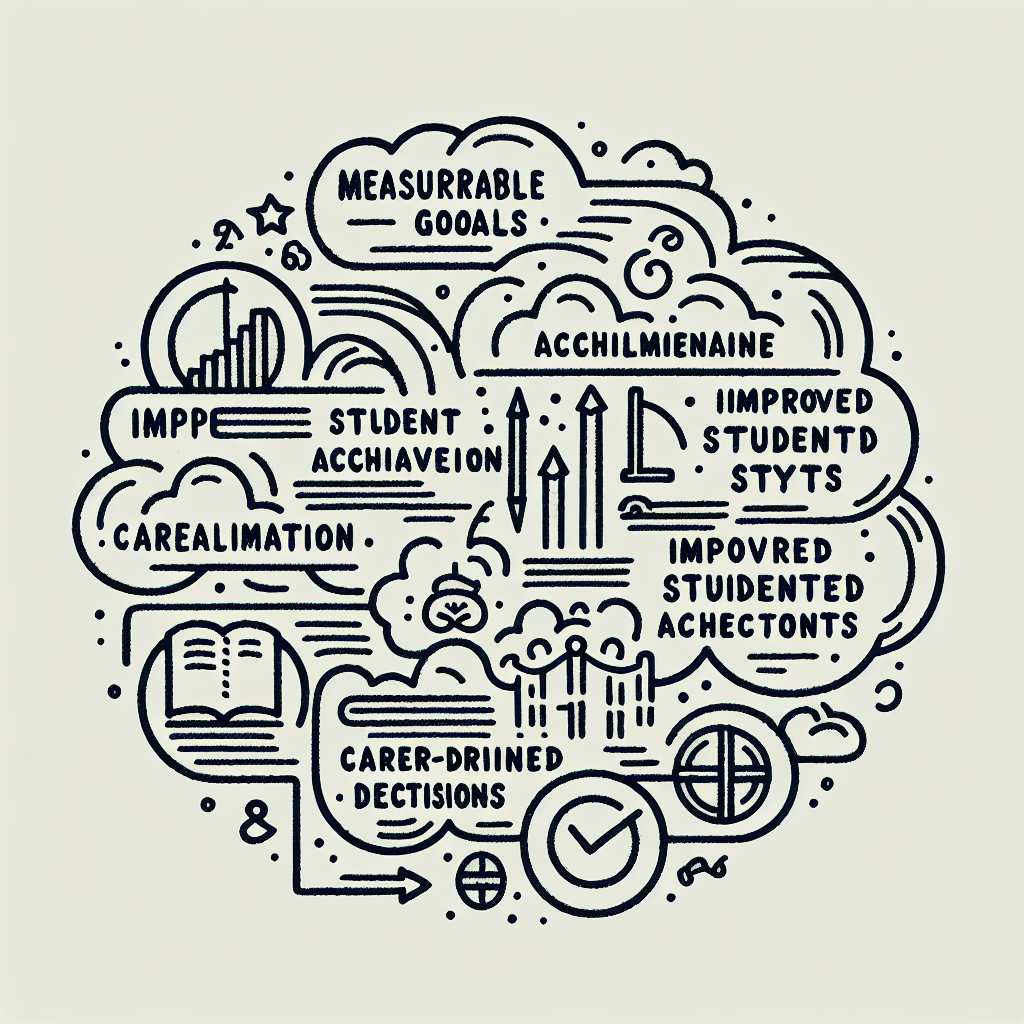Introduction
Setting clear and measurable goals for school is essential to improving educational outcomes across both K–12 and postsecondary systems. Educational goals can include academic benchmarks, such as literacy and numeracy proficiency, graduation rates, college enrollment, and workforce readiness. In the K–12 context, goals often focus on student achievement, equity, and school performance, while postsecondary goals may emphasize degree completion, retention rates, and career alignment.
Data-driven decision-making plays a central role in the goal-setting process. By analyzing trends and identifying gaps, educators and policymakers can create targeted strategies that are more likely to lead to meaningful improvements. Data helps ensure that goals are not only aspirational but also grounded in evidence, enabling ongoing evaluation and adjustment.
A variety of datasets support this process, including state and federal education statistics, standardized test results, graduation and attendance records, and longitudinal student tracking systems. These resources help stakeholders assess current performance, benchmark against peers, and monitor progress over time. Access to reliable data strengthens the ability of school leaders and policymakers to set realistic, impactful goals for school improvement at every level of education.

Understanding the Educational Landscape
Establishing effective goals for school requires a clear understanding of the broader educational landscape. Two key datasets from the U.S. Department of Education provide valuable insights into school and district characteristics that inform strategic planning.
Public School Characteristics Overview
The Public School Characteristics 2022-23 dataset serves as a comprehensive source of information on public schools across the United States. This dataset includes key metrics such as enrollment figures, teacher qualifications, and student demographic data. These details help educators and policymakers benchmark progress, identify areas for improvement, and align their goals for school with actual institutional needs. For example, understanding teacher certification rates or shifts in student populations can guide the development of targeted support programs.
School District Profiles
The School District Characteristics - Current dataset offers detailed district-level data that is essential for setting localized educational goals. This resource includes information on district size, funding levels, demographic composition, and academic outcomes. Examining these factors allows stakeholders to evaluate the equity of funding models and assess how well districts are meeting educational benchmarks. By leveraging this data, school leaders can create more informed and relevant goals for school that address the specific needs of their communities.

Core Components of Educational Goal Setting
Enrollment Trends and Impacts
Understanding enrollment trends is fundamental to setting effective goals for school systems. By tracking total enrollment by grade, districts can anticipate future needs, assess population shifts, and plan for appropriate resource allocation. For example, a spike in kindergarten enrollment may signal the need for more early childhood educators and classroom space, whereas declining high school enrollment could lead to reevaluations of course offerings and staffing.
Demographic breakdowns offer further insight into the student population. Schools must consider ethnicity, race, and language diversity to ensure inclusive educational practices. Additionally, analyzing socioeconomic indicators helps identify disparities in access to resources and informs goals aimed at promoting educational equity. These considerations are crucial for crafting policies that address the needs of all learners.
Teacher Quality and Workforce Readiness
Teacher quality plays a vital role in achieving meaningful goals for school improvement. Certification and licensure data help determine how qualified educators are distributed across schools. A lack of certified teachers in certain areas may contribute to unequal learning conditions. Ensuring that all schools have access to licensed educators supports better student outcomes and advances equity across districts.
Experience level is another key factor. Research consistently shows a positive correlation between years of teaching experience and student achievement. To support less experienced educators, mentoring programs and targeted professional development can be instrumental. These strategies not only enhance instructional quality but also contribute to teacher retention, further supporting long-term school goals.

Student Demographics and Individualized Goals
Setting effective goals for school involves considering the diverse backgrounds and needs of the student population. A one-size-fits-all approach can overlook critical differences in learning styles, access to resources, and personal circumstances.
Diversity and Inclusion
Schools serve students from various cultural, linguistic, and learning backgrounds. To support all learners, goals for school must be tailored to address this diversity. This includes adapting curriculum materials, providing language support for English language learners, and ensuring accessibility for students with disabilities. By aligning goals with students’ unique experiences, schools can foster a more inclusive environment. Targeted academic goals also help close achievement gaps, particularly for historically underserved populations, by focusing on specific performance metrics and support structures.
Socioeconomic Indicators
Socioeconomic status plays a significant role in student outcomes. Data such as free or reduced lunch eligibility, neighborhood income levels, and parental education can help identify at-risk students. Goals for school that consider these indicators allow educators to allocate resources more effectively—such as tutoring programs, counseling services, and technology access. Doing so helps promote equitable learning opportunities, ensuring that all students have the support they need to succeed.

Aligning K-12 Goals with Postsecondary Readiness
To effectively prepare students for life after high school, K-12 education systems must align their goals for school with the demands of postsecondary education and the workforce. This alignment ensures that students not only graduate but also possess the skills and knowledge necessary for success in college or career paths.
Postsecondary Access and Geography
Geographic disparities significantly influence students' access to postsecondary education opportunities. Using data from the Postsecondary School Locations - Current dataset, educators and policymakers can identify regions with limited proximity to colleges and universities. These insights can guide the development of targeted outreach programs, transportation solutions, or remote learning options to mitigate regional barriers. Addressing these disparities is essential for ensuring that all students, regardless of location, have equitable access as part of their broader goals for school.
College and Career Readiness Standards
Integrating academic content with technical skill development forms a foundation for authentic college and career readiness. States and districts are increasingly updating their goals for school to include rigorous standards that reflect both postsecondary expectations and labor market needs. This includes aligning high school graduation requirements with college entry standards and workforce competencies. Such alignment ensures that students can transition smoothly from high school into higher education or skilled careers without requiring remedial coursework or additional training.

Measuring Progress Toward Educational Goals
Statewide Performance Monitoring
Statewide performance monitoring plays a crucial role in tracking progress toward goals for school systems. One key resource is the Consolidated State Performance Report, 2011-12, which provides detailed information on graduation rates, academic assessment outcomes, and student participation in federally funded programs. These indicators help states evaluate how well they are meeting established educational benchmarks. Additionally, compliance with federal mandates such as the Every Student Succeeds Act (ESSA) ensures that all states maintain consistent standards in their pursuit of educational goals.
Student Assessment Data
Student assessment data is another critical measure of progress toward goals for school achievement. The EDFacts Assessment, 2017-18 dataset offers valuable insights into student proficiency in core subjects like math, reading, and science. By analyzing trends in assessment scores over time, educators and policymakers can identify areas of improvement and tailor instructional strategies accordingly. This data-driven approach supports the refinement of goals for school performance and helps ensure that educational practices are aligned with student needs.

Application of Data to Goal Development
Needs Assessment and Resource Allocation
Effective goals for school begin with a comprehensive needs assessment. Data such as student performance metrics, attendance records, and teacher-student ratios help identify gaps in infrastructure, staffing, and programming. For example, if standardized test scores show consistent underperformance in mathematics, it may indicate a need for additional instructional support or revised curriculum resources.
Once gaps are identified, schools can use data to prioritize funding. Empirical evidence guides decisions on where to allocate limited resources, ensuring that investments address the most critical areas. This data-driven approach helps align budget planning with strategic goals, leading to more efficient and equitable outcomes.
Strategic Planning and Policy Development
Data plays a central role in translating identified needs into strategic plans and policies. School improvement plans can be built around SMART goals—Specific, Measurable, Achievable, Relevant, and Time-bound. For instance, instead of a vague objective like "improve reading skills," a SMART goal would be: "Increase the percentage of third-grade students reading at or above grade level from 65% to 80% by the end of the academic year."
This precision allows schools to track progress and adjust strategies as needed. Data informs both the creation of these goals and the monitoring of their implementation, ensuring that policy development remains responsive and grounded in measurable outcomes.

Conclusion
Setting clear and achievable goals for school success requires more than ambition—it demands reliable, comprehensive data. Data serves as the foundation for identifying student needs, evaluating program effectiveness, and adjusting strategies to ensure every learner has the opportunity to thrive. Schools that use robust federal and local datasets are better equipped to make informed decisions that drive meaningful progress.
Continuous improvement is essential in today’s rapidly changing educational landscape. Schools must embrace adaptive goal-setting practices that respond to evolving student needs, policy shifts, and societal trends. This approach ensures that goals for school remain relevant and impactful over time.
By actively leveraging data from sources such as the U.S. Department of Education and local school assessments, educators and administrators can align their goals for school with evidence-based practices. Doing so not only promotes equity and excellence but also prepares students for success in a complex, future-oriented world.














